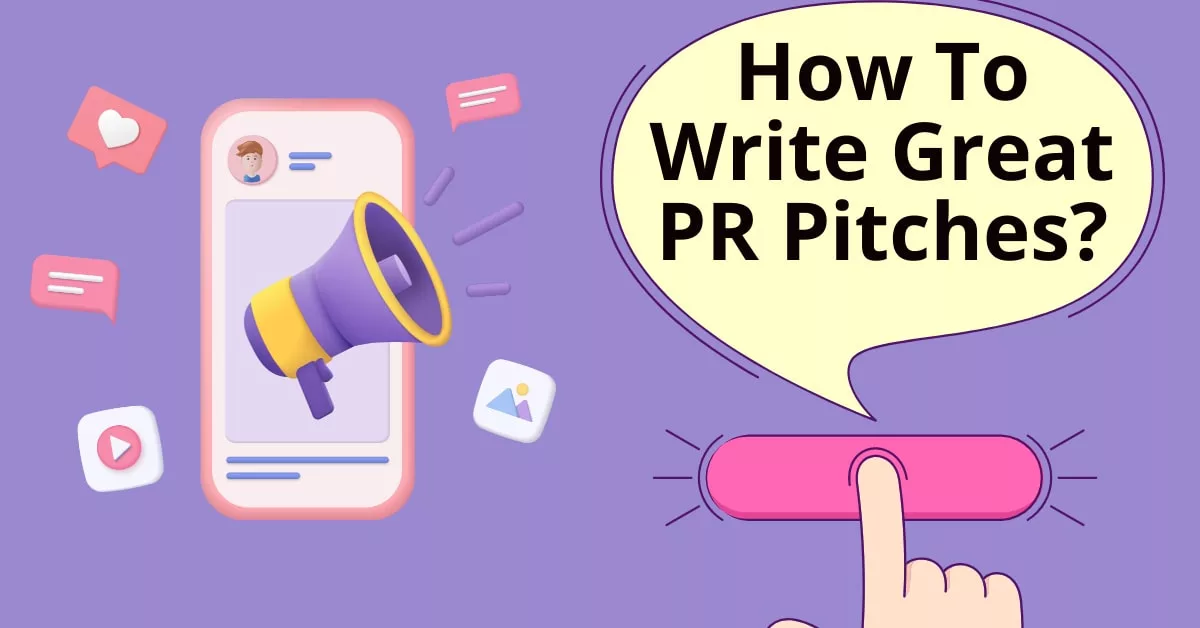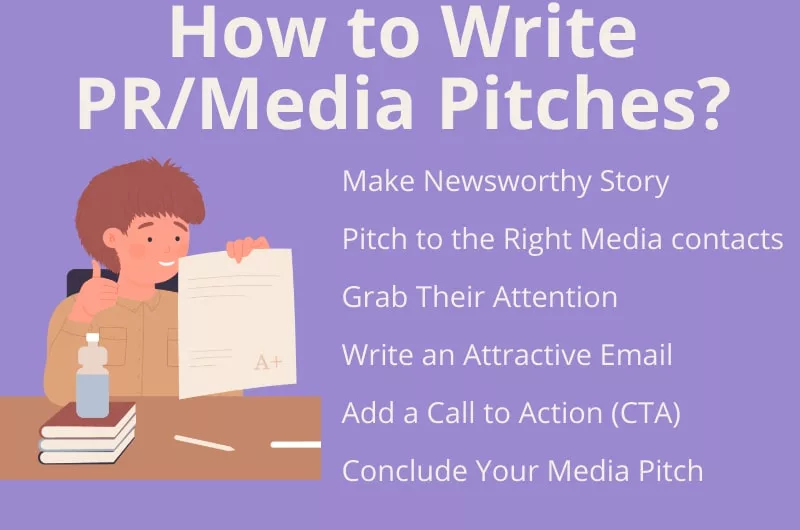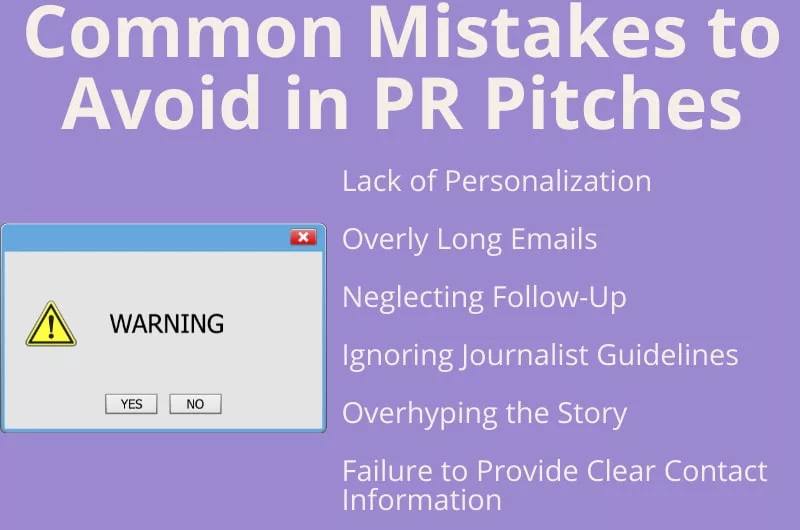How To Write Great PR Pitches? [With Examples]

by Avneet Singh
You only have a few seconds to grab the attention of busy journalists and media professionals. The art of crafting an effective PR pitch can make all the difference between capturing the attention of journalists and influencers or being lost in the noise. Whether you’re promoting a new product, announcing a milestone, or seeking to establish thought leadership, a well-crafted PR pitch is your ticket to securing valuable media coverage. In this guide, we’ll delve into the essential elements of writing great PR pitches that go well with media contacts and drive results. We will also discuss common mistakes to avoid and go through some media pitch templates.
How to Write PR/Media Pitches?
This section will guide you through essential strategies to get your media pitch noticed by your targeted journalists and media outlets.
Make Sure to Make Newsworthy Story
The cornerstone of any successful PR pitch is its newsworthiness. Journalists are inundated with pitches daily, so your story needs to stand out. Ask yourself: Does my pitch offer something timely, relevant, or unique? Is there a compelling angle that will capture the interest of readers or viewers? By focusing on what makes your story noteworthy, you increase the likelihood of media pickup. Align your narrative with current trends, recent studies, or emerging issues to increase its appeal. For instance, if a company is launching a new product, the angle could be how it addresses a common problem in a novel way.
Pitch to the Right Media Contacts
One size does not fit all when it comes to PR pitches. Research and identify the journalists, editors, or influencers who cover topics related to your media pitch. Customizing your pitch for the right person increases the likelihood of it being noticed. Tailor your pitch to each recipient, demonstrating that you understand their beat and audience. Personalization shows that you value their work and increases the chances of your pitch being well-received.
Grab Their Attention
With journalists receiving a flood of emails daily, you have only a few seconds to capture their attention. Craft a compelling subject line that succinctly conveys the essence of your media pitch and piques curiosity. In the body of your email, lead with a strong hook—a captivating opening sentence or statistic—to entice the recipient to continue reading. Start with a fact, question, or statement that immediately draws the reader in. Your opening lines should set the tone and hint at the value of your story.
Write an Attractive Email
Get to the point quickly without sacrificing important details. Journalists are time-pressed. So respect their time with brevity.
The body of your email should be concise, yet informative. Clearly outline the key points of your pitch, including the who, what, when, where, why, and how. Use bullet points or subheadings to break up the text and make it easier to digest. Be sure to include any relevant multimedia assets, such as images or videos, to enhance your pitch and provide visual interest.
While maintaining professionalism, infuse your personality or brand’s voice into the pitch. Balance formality with approachability.
Add a Call to Action (CTA)
Every PR pitch should include a clear call to action prompting the recipient to take the next step. Whether it’s scheduling an interview, requesting more information, or offering an exclusive opportunity, make it easy for journalists to engage with your pitch. By providing a clear CTA, you increase the likelihood of securing media coverage or building a relationship with the recipient. A call-to-action is your pitch’s handshake – firm, confident, and inviting further conversation. Provide necessary contact details, links, or additional resources that facilitate taking the desired action.
Conclude Your Media Pitch
End your pitch on a strong note by summarizing the key points and reiterating the value proposition. Express gratitude for the recipient’s time and consideration, and offer to provide any additional information or assistance they may need. Closing with a polite and professional sign-off reinforces a positive impression and leaves the door open for future communication. A simple thank you can go a long way in fostering a positive relationship with the media contact.
Common Mistakes to Avoid in PR Pitches
Here are some common mistakes you must avoid while writing PR pitches.
Lack of Personalization
One of the most common pitfalls in PR pitches is the failure to personalize. Sending out a mass, generic email is not only ineffective but often counterproductive. Tailoring your pitch to align with the journalist’s beat and previous work demonstrates that you have done your homework.
Overly Long Emails
Journalists are flooded with emails daily, so media pitches that are succinct yet comprehensive are more likely to be read. According to a survey by The Media Insight Project, journalists spend, on average, less than a minute reading a new pitch. Therefore, a pitch that gets straight to the point, ideally in under 200 words, is more likely to grab and retain their attention.
Neglecting Follow-Up
A common mistake in PR pitching is failing to follow up. While it’s crucial not to pester, a single, well-timed follow-up email can make all the difference. Wait for a week or so after your initial pitch before following up. This shows you respect the journalist’s time while still signaling your commitment to the story.
Ignoring Journalist Guidelines
Many media outlets and journalists have specific guidelines for media pitches. Ignoring these guidelines is a surefire way to get your pitch ignored. Whether it’s the format, length of press release, or type of content they prefer, adhering to these guidelines shows professionalism and respect for the journalist’s preferences and processes.
Overhyping the Story
Sensationalizing the story in your pitch can damage your credibility. Overhyping can lead to disappointment and a loss of trust. As a senior editor at a leading magazine notes, “We look for stories that intrigue, not pitches that oversell.”
Failure to Provide Clear Contact Information
Sometimes PR professionals forget to include clear and easy ways to get back in touch. Ensure your email signature has your full contact details, including your phone number and social media handles. This might seem basic, but it’s a common oversight.
Media Pitch Templates
Let’s understand better by looking at some media pitch examples
Example 1: Product Launch Pitch
Subject Line: “Revolutionizing Home Fitness: Launching the SmartMat – Yoga Reimagined”
Dear [Journalist’s Name],
I hope this email finds you well. I’m reaching out to share an exciting development in the world of home fitness that I believe will greatly interest your readers.
This month, ZenFit is launching the SmartMat – a groundbreaking yoga mat integrated with AI technology to guide, correct, and enhance your yoga practice. In a world where health and technology increasingly intersect, the SmartMat represents a significant leap forward.
Our CEO, Jane Doe, a renowned yoga instructor and tech entrepreneur, is available for an interview to discuss the intersection of technology and wellness, and how the SmartMat is set to change the game.
Would you be interested in covering this launch? We can provide exclusive images, a product demo, and early access to the app that accompanies the SmartMat.
Thank you for considering this pitch. I look forward to the possibility of working together on this story.
Best regards,
[Your Name]
Example 2: Event Announcement Pitch
Subject Line: “Invitation: Join the Global Climate Action Symposium – Voices for Change”
Hi [Journalist’s Name],
With the urgent need for climate action, the upcoming Global Climate Action Symposium (GCAS) is an event that promises to make waves – and I believe your coverage could amplify its impact.
Scheduled for [Date], this symposium will bring together influential leaders, activists, and scientists to discuss innovative solutions to combat climate change. Highlights include a keynote speech from environmentalist Dr. John Green and a panel discussion on sustainable urban development.
As an expert in environmental reporting, your perspective on this event would be invaluable to your audience. We would be delighted to arrange exclusive interviews with key speakers and provide you with a press pass for full access to the event.
Please let me know if you would be interested in covering the GCAS. I am happy to provide more details upon request.
Thank you for your time and consideration.
Warm regards,
[Your Name]
Conclusion
Crafting great PR pitches is both an art and a science. By focusing on newsworthiness, targeting the right media contacts, grabbing attention, writing attractive emails, adding CTAs, and concluding effectively, you can significantly increase your chances of securing valuable media coverage. Remember, successful PR pitching is about building relationships, telling compelling stories, and providing value to journalists and their audiences. With practice and persistence, you can master the art of the pitch and elevate your brand’s visibility in the media landscape.
Recommended Posts

10 Common Press Release Mistakes & How To Fix Them?
March 8, 2024

How to Write Great Press Release Headlines?
February 15, 2024

How to Write a Press Release for a Book?
January 30, 2024



